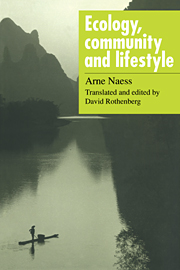Book contents
- Frontmatter
- Contents
- Translator's preface
- Introduction: Ecosophy T – from intuition to system
- 1 The environmental crisis and the deep ecological movement
- 2 From ecology to ecosophy
- 3 Fact and value; basic norms
- 4 Ecosophy, technology, and lifestyle
- 5 Economics within ecosophy
- 6 Ecopolitics within ecosophy
- 7 Ecosophy T: unity and diversity of life
- Bibliography
- Index
Introduction: Ecosophy T – from intuition to system
Published online by Cambridge University Press: 13 October 2009
- Frontmatter
- Contents
- Translator's preface
- Introduction: Ecosophy T – from intuition to system
- 1 The environmental crisis and the deep ecological movement
- 2 From ecology to ecosophy
- 3 Fact and value; basic norms
- 4 Ecosophy, technology, and lifestyle
- 5 Economics within ecosophy
- 6 Ecopolitics within ecosophy
- 7 Ecosophy T: unity and diversity of life
- Bibliography
- Index
Summary
The system begins with the immediate … The beginning of the system is the absolute beginning … How does the system begin with the immediate? Does it begin with it immediately? The answer to this question must be an unqualified no.
Søren Kierkegaard Concluding Unscientific PostscriptWe feel our world in crisis. We walk around and sense an emptiness in our way of living and the course which we follow. Immediate, spontaneous experience tells us this: intuition. And not only intuition, but information, speaking of the dangers, comes to us daily in staggering quantities.
How can we respond? Has civilisation simply broken away hopelessly from a perfection of nature? All points to a bleak and negative resignation.
But this is only one kind of intuition – there is also the intuition of joy.
Arne Naess gives a lecture somewhere in Oslo. After an hour he suddenly stops, glances quickly around the stage, and suddenly leaves the podium and approaches a potted plant to his left. He quickly pulls off a leaf, scurries back to the microphone, and gazes sincerely at the audience as he holds the leaf in the light so all can see. ‘You can spend a lifetime contemplating this’, he comments. ‘It is enough. Thank you.’
In 1969, Naess resigned his professorship in philosophy after over thirty years of work in semantics, philosophy of science, and the systematic exposition of the philosophies of Spinoza and Gandhi.
- Type
- Chapter
- Information
- Ecology, Community and LifestyleOutline of an Ecosophy, pp. 1 - 22Publisher: Cambridge University PressPrint publication year: 1989



